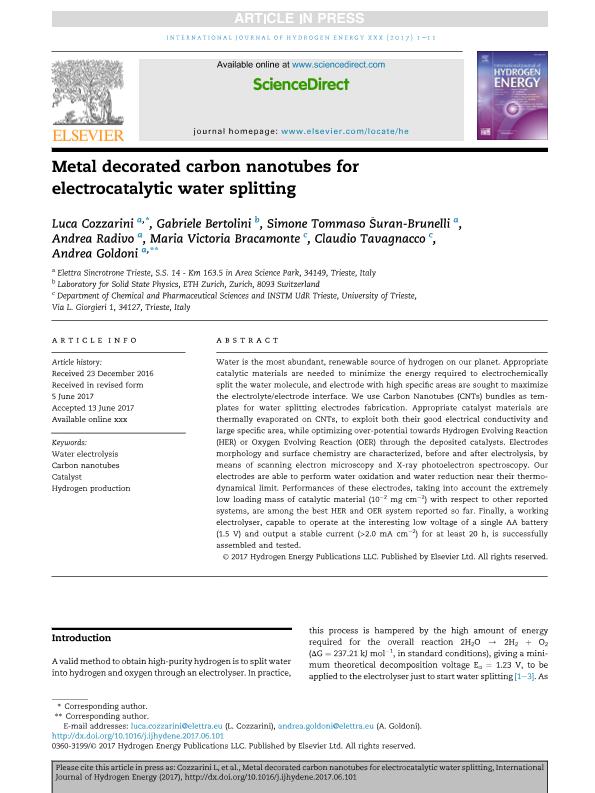Mostrar el registro sencillo del ítem
dc.contributor.author
Cozzarini, Luca
dc.contributor.author
Bertolini, Gabriele
dc.contributor.author
Suran Brunelli, Simone Tommaso
dc.contributor.author
Radivo, Andrea
dc.contributor.author
Bracamonte, Maria Victoria

dc.contributor.author
Tavagnacco, Claudio
dc.contributor.author
Goldoni, Andrea
dc.date.available
2018-11-16T17:21:39Z
dc.date.issued
2017-07-27
dc.identifier.citation
Cozzarini, Luca; Bertolini, Gabriele; Suran Brunelli, Simone Tommaso; Radivo, Andrea; Bracamonte, Maria Victoria; et al.; Metal decorated carbon nanotubes for electrocatalytic water splitting; Pergamon-Elsevier Science Ltd; International Journal of Hydrogen Energy; 42; 30; 27-7-2017; 18763-18773
dc.identifier.issn
0360-3199
dc.identifier.uri
http://hdl.handle.net/11336/64618
dc.description.abstract
Water is the most abundant, renewable source of hydrogen on our planet. Appropriate catalytic materials are needed to minimize the energy required to electrochemically split the water molecule, and electrode with high specific areas are sought to maximize the electrolyte/electrode interface. We use Carbon Nanotubes (CNTs) bundles as templates for water splitting electrodes fabrication. Appropriate catalyst materials are thermally evaporated on CNTs, to exploit both their good electrical conductivity and large specific area, while optimizing over-potential towards Hydrogen Evolving Reaction (HER) or Oxygen Evolving Reaction (OER) through the deposited catalysts. Electrodes morphology and surface chemistry are characterized, before and after electrolysis, by means of scanning electron microscopy and X-ray photoelectron spectroscopy. Our electrodes are able to perform water oxidation and water reduction near their thermo-dynamical limit. Performances of these electrodes, taking into account the extremely low loading mass of catalytic material (10−2 mg cm−2) with respect to other reported systems, are among the best HER and OER system reported so far. Finally, a working electrolyser, capable to operate at the interesting low voltage of a single AA battery (1.5 V) and output a stable current (>2.0 mA cm−2) for at least 20 h, is successfully assembled and tested.
dc.format
application/pdf
dc.language.iso
eng
dc.publisher
Pergamon-Elsevier Science Ltd

dc.rights
info:eu-repo/semantics/openAccess
dc.rights.uri
https://creativecommons.org/licenses/by-nc-sa/2.5/ar/
dc.subject
Carbon Nanotubes
dc.subject
Catalyst
dc.subject
Hydrogen Production
dc.subject
Water Electrolysis
dc.subject.classification
Otras Ciencias Químicas

dc.subject.classification
Ciencias Químicas

dc.subject.classification
CIENCIAS NATURALES Y EXACTAS

dc.title
Metal decorated carbon nanotubes for electrocatalytic water splitting
dc.type
info:eu-repo/semantics/article
dc.type
info:ar-repo/semantics/artículo
dc.type
info:eu-repo/semantics/publishedVersion
dc.date.updated
2018-10-22T18:20:51Z
dc.identifier.eissn
1097-458X
dc.journal.volume
42
dc.journal.number
30
dc.journal.pagination
18763-18773
dc.journal.pais
Países Bajos

dc.journal.ciudad
Ámsterdam
dc.description.fil
Fil: Cozzarini, Luca. Elettra Sincrotrone Trieste; Italia
dc.description.fil
Fil: Bertolini, Gabriele. ETH Zurich; Suiza
dc.description.fil
Fil: Suran Brunelli, Simone Tommaso. Elettra Sincrotrone Trieste; Italia
dc.description.fil
Fil: Radivo, Andrea. Elettra Sincrotrone Trieste; Italia
dc.description.fil
Fil: Bracamonte, Maria Victoria. Consejo Nacional de Investigaciones Científicas y Técnicas; Argentina. University of Trieste; Italia
dc.description.fil
Fil: Tavagnacco, Claudio. University of Trieste; Italia
dc.description.fil
Fil: Goldoni, Andrea. Elettra Sincrotrone Trieste; Italia
dc.journal.title
International Journal of Hydrogen Energy

dc.relation.alternativeid
info:eu-repo/semantics/altIdentifier/url/http://linkinghub.elsevier.com/retrieve/pii/S0360319917324151
dc.relation.alternativeid
info:eu-repo/semantics/altIdentifier/doi/https://dx.doi.org/10.1016/j.ijhydene.2017.06.101
Archivos asociados
